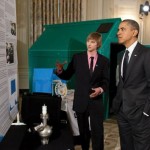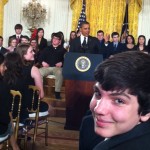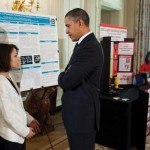Science at the White House
Students with big achievements in science, engineering met with the president February 7

This week, the president of the United States invited some big winners to the White House. And no, they don’t play football.
February 7 marked the second ever White House Science Fair. About 100 middle school, high school and college students from across the country got a special invitation to spend the morning meeting with the president and his top scientists. Ten students who had competed in national academic challenges sponsored by Society for Science & the Public — or SSP, publisher of Science News for Kids — were among those honored. Some students even presented their projects to President Barack Obama himself.
“If we invited the team that won the Super Bowl to the White House, then we need to invite some science fair winners as well,” President Obama said during a speech at the fair.
Projects the president learned about firsthand included a study on how mussels defend themselves from crab attacks and new ways to detect hidden nuclear material.
The first White House Science Fair took place in October 2010 and included 16 exhibits. This year, the president’s staff invited more than twice that many participants to display their work. Thirty-three students brought in robots, rockets and posters, while dozens of other students attended to hear the president’s speech. Many had invented devices or made discoveries that helped their communities.

In his speech, the president specifically mentioned Benjamin Hylak and his rolling robot, MAYA (which stands for Me And You Anywhere). This 14-year-old student from Salesianum High School in Wilmington, Del., designed the device to make it easier for elderly people living in nursing homes — such as his own grandmother — to talk to their families. Hylak fashioned the robot’s body from a recycled trash can and used a computer for a face. That computer can make video chat calls to any other computer through a camera connected to the Internet. Hylak previously won second place for his invention at the 2011 Broadcom MASTERS competition.
Everyone at the White House fair got to have a bit of fun, like watching the president shoot off a marshmallow gun. In an office known as the State Dining Room, the president helped blast a ball of squishy sugar from a long cannon powered totally by air. As he used a bicycle pump to fill the cannon with air, he joked: “Secret Service isn’t happy about this.”
“It’s not every day that you have robots running all over your house,” the president said in his speech. “I am trying to figure out how you got through the metal detectors.”

Other students who had competed in challenges sponsored by SSP also got to show off their accomplishments to the president. Taylor Wilson, a 17-year-old who attends the Davidson Academy of Nevada in Reno, devised a new way to find a type of nuclear material used in weapons, even when the material is buried deep inside a cargo container. In 2011, he was given an Intel Young Scientist award at the Intel International Science and Engineering Fair.
Samantha Garvey, an 18-year-old from Brentwood High School in Brentwood, N.Y., told the president what she had learned about mussels living in Long Island Sound, near her home. Mussels, which cling tightly to rocks, tend to grow very thick shells if they’re close to a type of predator called the Asian shore crab. That tough shield, she says, protects the kidney bean–shaped mussel from becoming a crab’s lunch. Mussels growing outside the crab’s range didn’t put so much energy into their shells. This work qualified her as a semifinalist in the 2012 Intel Science Talent Search.
“These outstanding SSP alumni are representative of the thousands of students competing each year in our programs, around the country and the world,” said Elizabeth Marincola, president of SSP. Their intelligence, creativity and discipline may one day turn up answers to some of our most pressing challenges, she said.
And, of course, it’s always an honor to the meet the president. Taylor Wilson says that Obama was tall, just not as tall as he had been told. “I was not as intimidated as I thought I would be,” he says.
In addition to Hylak, Wilson and Garvey, SSP alumni who attended the White House Science Fair this year included:
Eta Atolia, 18, now a student at the Massachusetts Institute of Technology. She was selected as a finalist in the 2011 Intel Science Talent Search for her biochemistry project titled, “Preferred polar lipids of marine eustigmatophyte, Nannochloropsis oculata: Assessing potential as biofuel feedstock and eicospentaenoic acid producer.”
Marian Bechtel, 17, a junior at Hempsfield High School in Lancaster, Pa. She was selected as a finalist at the 2011 Intel International Science and Engineering Fair for her project titled, “A stand-off seismo-acoustic method for humanitarian demining.”
Emily Chen, 18, now a student at Harvard University. While in high school, she was selected as a finalist in the 2011 Intel Science Talent Search for her project titled, “A novel, dual role of cytokine-mediated activation of STAT3 in brain inflammation and neural progenitor cell differentiation.”
Tanner Coppin, 18, a senior at Hankinson High School in Hankinson, N.D. He was selected as a finalist at the 2011 Intel International Science and Engineering Fair for his project titled, “The agricultural impact of curlycup gumweed on barley cultivars.”
Taide Ding, 17, a junior at Oxford High School in Oxford, Miss. He was selected as a finalist at the 2011 Intel International Science and Engineering Fair for his project, “Nonlinear parametric modeling of hurricane landfall decay.”
Michelle Hackman, 18, now a student at Yale University. In high school, she was selected as a finalist in the 2011 Intel Science Talent Search for her project titled, “Communication underload: Validating the existence of disconnect anxiety.”
Coleman Kendrick, 13, an eighth-grade student at Los Alamos Middle School in Los Alamos, N.M. He was selected as a finalist at the 2011 Broadcom MASTERS for his project, “Computer simulation of dark matter effects on galaxy rotation.”